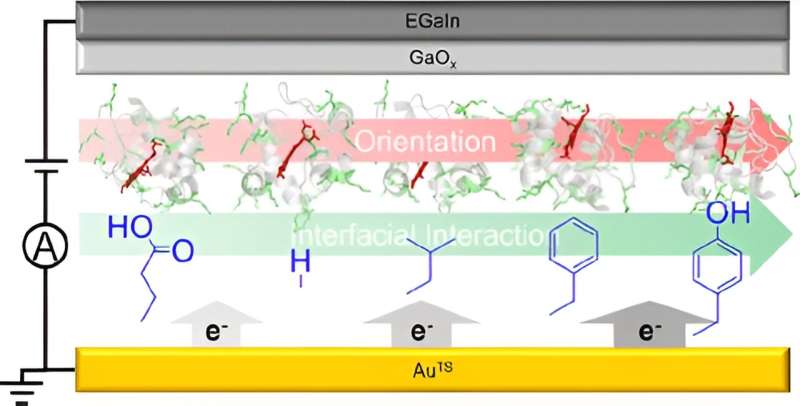This article has been reviewed according to Science X's editorial process and policies. Editors have highlighted the following attributes while ensuring the content's credibility:
fact-checked
peer-reviewed publication
proofread
The role of interfacial amino acids in shaping bio-electronic communication between proteins

Proteins are vital for facilitating charge transport (CT) chain reactions, both within individual proteins and between proteins. Understanding CT in proteins is crucial for biological processes and the development of bioelectronic devices. While previous research has focused on CT within proteins, less attention has been given to inter-protein CT. Recent studies suggest that specific interactions between proteins are stabilized by interfacial amino acids, potentially mediating CT between proteins.
In a new study published in Nano Letters, Guo and coworkers from Wuhan University have proposed a precisely controlled platform to investigate the roles of interfacial amino acids in inter-protein CT using solid-state molecular junctions.
This innovative approach combines molecular self-assembly with solid-state techniques to sensitively reflect variations in molecular composition and conformation without additional labeling. By constructing well-defined self-assembled monolayers (SAMs) of peptides immobilized with cytochrome c (Cyt c) monolayers, researchers created a model system to study protein–protein interactions.
Through meticulous experimentation, the researchers demonstrated the crucial roles of interfacial amino acids in facilitating efficient CT. By modulating the interfacial environment, they were able to regulate the energy barrier for CT and precisely control the orientation of immobilized Cyt c. The study revealed that different amino acid compositions at the peptide terminus resulted in significant differences in CT efficiency, highlighting the importance of interfacial amino acids in mediating CT across proteins.
Furthermore, the study provided insights into the orientation of immobilized Cyt c on peptide SAMs and its correlation with CT efficiency. By analyzing energy barriers and coupling strengths of peptide-Cyt c junctions, researchers identified the intricate interplay between interfacial amino acids, protein orientation, and CT efficiency.
Overall, this research significantly advances our understanding of inter-protein CT and offers a valuable tool for studying the role of interfacial amino acids in mediating CT across proteins. The findings have implications for designing bioelectronic devices and elucidating the fundamental principles underlying biological charge transport.
More information: Yongkang Zhang et al, Deciphering the Roles of Interfacial Amino Acids in Inter-Protein Charge Transport, Nano Letters (2024). DOI: 10.1021/acs.nanolett.4c00164
Journal information: Nano Letters
Provided by Wuhan University




















